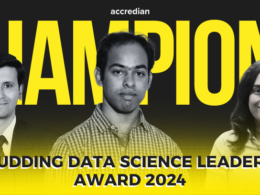Is becoming a data scientist your dream? Does data science fascinate you? Well keep reading this blog if you’re passionate about data science, because we will tell you the what, how and why of Data Science.
Let’s start by understanding what data science is.
Now data science combines multiple fields, which includes statistical methods, artificial intelligence and data analysis to extract value from data. So, those who practise data science are called data scientists.
They apply a range of skills to analyse data collected from the web, smartphones, customers, sensors and other sources to derive actionable insights.
Now, data science encompasses preparing data for analysis, including cleansing, aggregating and manipulating the data to perform advanced data analysis.
Right now, data science is one of the most exciting fields out there.
But why is it so important? Well, the data volumes have exploded, as modern technology has enabled the creation and storage of an increasing amount of information, which is quite easy and accessible for us right now.
It is estimated that 90% of the data in the world was created in the last two years! For example, Facebook users upload 10 million photographs every hour, which in itself is very astonishing.
But this data is often just sitting in databases and that data lays mostly untouched.
The wealth of data being collected and stored by these technologies, can bring transformative benefits to organisations and societies around the world, but only if we are able to interpret it properly.
Now, this is where data science comes in. Data science reveals trends and it produces insights that businesses can use to make better decisions and create more innovative products and services.
Perhaps more importantly, it enables machine learning models to learn from the vast amount of data being fed to them, rather than mainly relying upon business analysis to see what they can discover from the data.
Now, data is basically the bedrock of innovation, but its value comes from the information data scientists can gain from it and then act upon it. So the very obvious question comes:
Who is a data scientist?
As a field, data science is quite new. It grew out of the fields of statistical analysis and data mining. There is something called the data science journal, which debuted in 2002.
It was published by the International Council for Science Committee on data science and technology, 2002. But by 2008, the title of data scientist had actually been coined and people were almost familiar.
The field took off very quickly. There has been a shortage of data scientists ever since, even though more and more colleges and universities have started offering data science degrees.
So a data scientist’s duties can include,
- Developing strategies for analysing data
- Preparing data for analysis
- Exploring, analysing, and visualising data
With all of this they build models with data using programming languages, such as Python and are frequently deploying models into applications. Now, that being said, data scientists don’t work alone.
In fact, the most effective data science tasks are done in dedicated teams. So in addition to a data scientist this team might includes:
- A business analyst who defines the problem
- A data engineer who prepares the data and how it is accessed
- An IT architect who oversees the underlying processes and infrastructure
- An application developer who deploys the models or outputs of the analysis into application and products
Now with all of this being done, how is data science transforming businesses for us?
Organisations are using data science to turn data into a competitive advantage by refining the products and services.
Data science and machine learning applies the user case to determine customer churn by analysing data collected from call centres, so that marketing teams can take calculated actions.
Secondly, they improve efficiency by analysing traffic patterns, weather conditions and other factors. For example, logistic companies can improve delivery speeds and reduce costs of all of your Amazon deliveries, which really depend on these.
Thirdly, they improve patient diagnosis by analysing medical test data and reported symptoms, so doctors can diagnose diseases earlier and treat them more effectively.
Fourthly, they optimise the supply chain by predicting when an equipment will break down. And lastly they detect fraud in financial services by recognizing suspicious behaviour and anomalous actions.
These are just some of the benefits that data science is bringing in our day to day life. So, what are certain tools for data science that we can use?
So building, evaluating, deploying and monitoring machine learning models can be a very complex process. That’s why there has been an increase in the number of data science tools.
Now data and fine tests use many types of tools, but one of the most common is open source notebooks. They are basically web applications for writing and running code.
They run code, they visualise data and then they finally see the result, all in the same environment. So some of the most popular notebooks that exist for data scientists are Jupiter, RStudio and Zeppelin.
Notebooks are very useful for conducting analysis, but they do have their limitations when data scientists need to work as a team. So data science platforms were built to solve this particular problem.
No to determine which data science tool is right for you, it’s important to ask the following questions- ‘What kind of language do your data scientists use? What kind of working methods do they prefer? What kind of data sources are they using?’
For example, some users prefer to have a data source agnostic service that uses open source libraries, others prefer the speed of the database, which can also be called machine learning algorithms.






4 comments